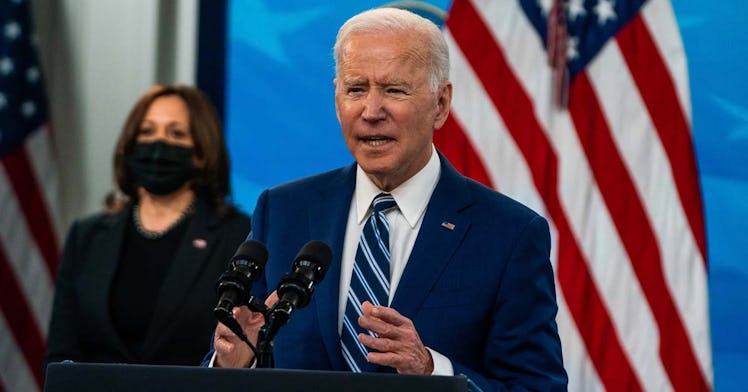What Parents Need to Know About Biden’s $2 Trillion Infrastructure Package
The American Jobs Act could be the most consequential law of his presidency. But is it enough?

President Biden is set to introduce the American Jobs Plan, his $2 trillion infrastructure package, in Pittsburgh later today, 20 days after he signed the American Rescue Plan Act. It’s might be the most boringly named piece of legislation in American history, but the effect it would have on the country if passed is anything but.
The White House is billing the proposal as “an investment in America that will create millions of good jobs, rebuild our country’s infrastructure, and position the United States to out-compete China” and return the country to levels of public investment not seen since the Space Race and construction of the Interstate Highway System.
Here’s what you need to know about the American Jobs Plan, including what it would accomplish, whether or not it can actually pass, and whether it’s an adequate salvo against the challenges we face as a country.
What’s in the American Jobs Plan?
According to a detailed statement released by the White House, these are the main priorities of the American Jobs Plan:
- investing in transportation (surface, seaports, airports, public transit)
- investing in home utilities (water, electric, broadband)
- investing in building modernization and upgrades
- investing in the care economy
- building up the manufacturing and the supply chain
- protecting workers’ rights to organize and bargain collectively (essentially, the PRO Act)
The bill contains a mixture of physical and human infrastructure investment, of fixes to discrete problems like decaying bridges, and measures addressing complex, massive issues like climate change and racial injustice.
The bill could replace every lead pipe in America, give every American access to high-speed broadband by the end of the decade, and create a nationwide network of electric vehicle charging stations. It’s part of a vision of what government can and should do for its citizens.
How is it financed?
Unlike the American Rescue Plan, which was financed by essentially printing more money, the American Jobs Plan is paid for via tax increases on businesses and the wealthy. It would increase the corporate tax rate from 21 to 28 percent and the global minimum tax from 13 to 21 percent. The plan would also end federal tax breaks for fossil fuel companies and fund stricter enforcement of tax laws that would increase revenue without raising tax rates themselves.
Biden and company claim that the changes to the tax code in what they’ve termed the “Made in America” tax plan would fully pay for the plan within the next 15 years and reduce deficits after that.
Does it do enough?
Two trillion dollars might sound like an adequately massive amount of money, but many in the Democratic Party’s progressive wing say that it’s not enough. They’ve pointed out that during the campaign, Biden proposed $2 trillion in spending over four years, in effect two-and-a-half times what he’s pushing for now, the same amount of money spread over ten years.
Senator Ed Markey and Representative Debbie Dingell are the lead sponsors of a $10 trillion infrastructure bill that is more ambitious than Biden’s in almost every way—and still framed as a “down payment” on the Green New Deal, which is as much an infrastructure bill as it is an environmental bill.
And they might have a point. Even in the statement introducing his proposal, Biden cites a “trillion-dollar backlog of needed repairs” for roads, bridges, and transit systems. In the next paragraph, however, it promises to invest just $621 billion.
There is also consternation that the administration is leaving important measures like extending the new time-limited child tax credit for a separate bill that will address “human infrastructure” that the administration is expected to introduce in the coming weeks. What that package looks like will play a key role in how this first package is perceived.
Will it become law?
The tax increases that pay for this spending are already being decried by Republicans for whom minimizing taxes for businesses and the rich are sacrosanct. At this point, it’s difficult to imagine this bill attracting any Republican support, particularly in the Senate.
Democrats are going to have plenty of objections to Biden’s bill as well. There’s the aforementioned grumbling among the Progressive Caucus that it’s too limited, but so-called centrist Democrats will likely feel that it’s too expansive and resent being asked to vote for a tax increase. Three House Democrats have already vowed to oppose the package because it doesn’t remove a cap on state and local tax deductions instituted by the Trump administration, a move that would mostly benefit high earners.
How long could it take to pass?
Without the deadline to extend unemployment benefits and the general urgency of the pandemic that fueled the passage of the American Rescue Plan, Democrats also don’t have as much of an incentive to set aside their differences and pass the bill quickly. Expect months of wrangling in both Houses of Congress.
And even if they arrive on a bill that can pass the House, making the American Jobs Act law will require lots of horse-trading in the Senate. Budget reconciliation, the process that allows certain bills to pass with just 50 votes, is only supposed to be used once per fiscal year. Since the Democrats used it to pass their COVID relief bill, it technically shouldn’t be allowed again until October, though they could appeal to the parliamentarian and/or overrule her if she rules against them.
Modifying or getting rid of the filibuster is also a legitimate option for the Democrats if they can get the reticent centrists on board. That would allow them to pass the American Jobs Act with a simple majority and make passing more (and more transformational) legislation while they control both houses of Congress and the White House, an era likely to end with the 2022 midterms, much easier.